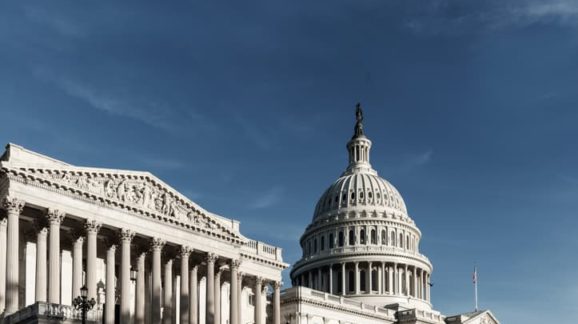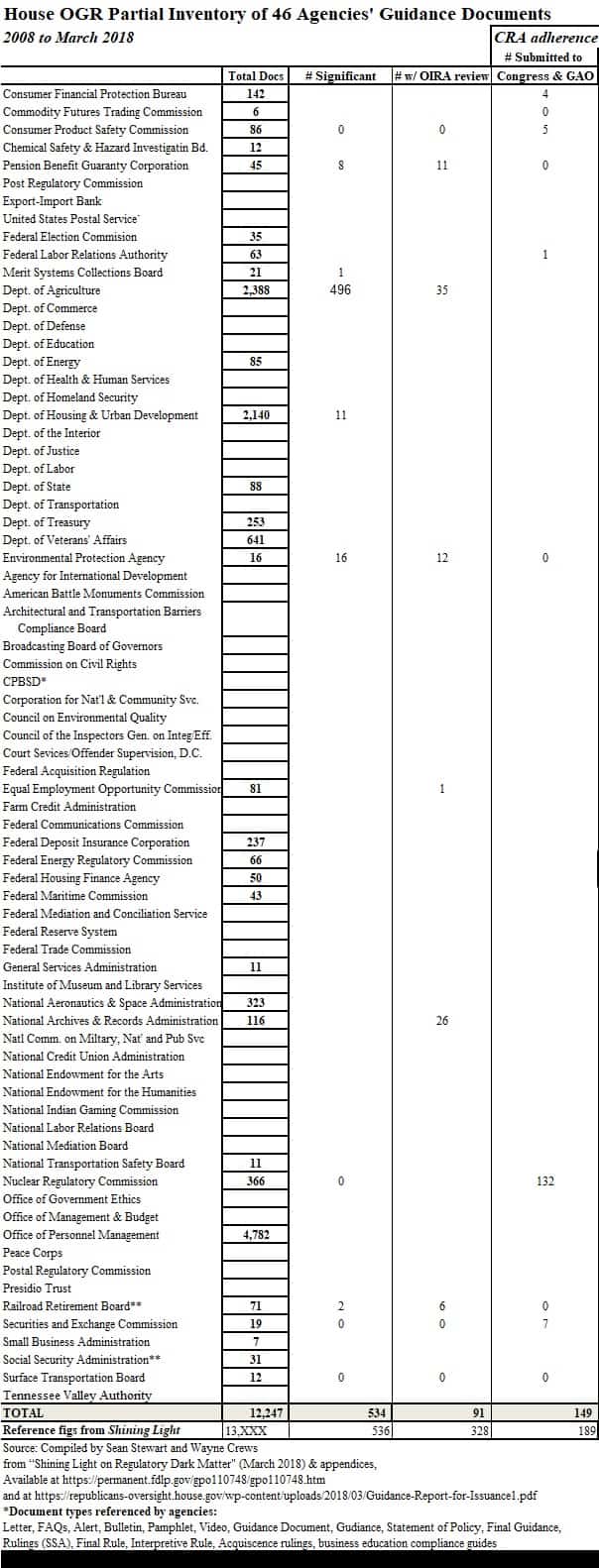A Partial Inventory of Federal Agency Guidance Documents Before Trump’s Official Compendium Comes Due

 A couple years back, the then-Republican House Oversight and Government Reform (OGR) committee released a report compiling responses from 46 federal agencies regarding a list of their outstanding guidance documents, and whether the documents had complied with relevant requirements for Office of Management and Budget (OMB) cost-benefit review and with Congressional Review Act (CRA) requirements that guidance be submitted to Congress and the Government Accountability Office.
A couple years back, the then-Republican House Oversight and Government Reform (OGR) committee released a report compiling responses from 46 federal agencies regarding a list of their outstanding guidance documents, and whether the documents had complied with relevant requirements for Office of Management and Budget (OMB) cost-benefit review and with Congressional Review Act (CRA) requirements that guidance be submitted to Congress and the Government Accountability Office.
Earlier I took a look at the OGR findings, and surveyed them in a report calling for a new executive order from the Trump administration to rein in guidance document abuse, so won’t repeat any of that here, other than to say that an inventory of over 13,000 guidance documents was reported to have been issued since 2008 by 46 agencies, although this is nowhere close to the total.
There are a lot more agencies than 46, of course, and even after the command of OGR, 11 agencies provided partial responses, and eight “did not produce any information about their guidance documents.”
Of the13,000, 536 were deemed “significant” and 328 were reported to have received OMB review. While all were supposed to have been submitted per the CRA, just 189 were.
With respect to the latter, agencies have received a different command. President Trump issued and executive order on “Promoting the Rule of Law Through Improved Agency Guidance Documents” in October 2019. They have a big deadline coming up in two weeks on February 28, since agencies were given 120 days to make all their guidance documents publicly available on a single website. Anything not listed is void according to the order, although agencies get until July to include anything they overlooked that had been published before Trump’s order.
Since the executive order, agencies were further directed by OMB’s Office of Information and Regulatory Affairs:
… by February 28, 2020 to establish a single, searchable, indexed website that contains, or links to, all of the agencies’ respective guidance documents currently in effect. By that same date, agencies should send to the Federal Register a notice announcing the existence of the new guidance portal and explaining that all guidance documents remaining in effect are contained on the new guidance portal.
I just want here to reflect on the magnitude of this job and sound another warning about agency resistance.
When OGR produced the 23-page Shining Light on Regulatory Dark Matter report, it did not provide within it the count of each agencies’ documents; it simply noted totals and listed the agencies.
The actual lists of guidance documents were contained separately in appendices consisting of thousands of pages. And even in the appendices, agencies often did not tally or summarize the count of agencies’ responses. There were, where received, often lists.
Guidance types referenced by agencies? You name it. In this case, they included: Letter, FAQs, Alert, Bulletin, Pamphlet, Video, Guidance Document, Guidance, Statement of Policy, Final Guidance, Final Rule, Interpretive Rule, Acquiescence rulings (SSA), Rulings (SSA); Business Education Compliance Guides,
Using those hefty, impenetrable appendices, my colleague Sean Stewart helped me compile a preliminary tally of the rule counts in the appendices (and we stress preliminary), which appears below.

The agencies’ “infodata” dumps and semi-counts were loaded with qualifiers and disclaimers. They were preliminary, inexact, given up under protest, and jumbles of apples and oranges. Note in the chart too that some agencies that obviously have guidance documents did not report anything. In other cases, agencies (Railroad Retirement Board, Social Security Administration) declared that, whether due to the nature of guidance document (legal opinion or internal procedure) or any other reason, that many (if not all) do not need to submitted to anybody (so go jump in the lake).
Others (Interior) claimed they could not respond in a timely manner (not so since anybody could do at least some of it clicking around on the Web in an afternoon). The fact that some agencies and departments had owned up to no guidance is likely to be called into question if they persist in the new mandatory inventory coming soon. (In a separate tally of guidance documents, this author fills in some of those gaps).
Our chart nearby includes only what agencies made obvious, and we have no doubt that anyone combing through the same materials will find different counts.
The list of agencies appearing here is longer than OGR’s 46, since I like to use the more “complete” list of rulemaking agencies that appears in the twice-yearly Unified Agenda of regulatory actions. The tally here of “significant” closely matches that of the Shining Light report, but we come up a tad short of the 13, 000 (at 12,247) grand total. And we are nowhere close to finding in the details anything to justify agencies’ already weak claims of compliance with OMB review and the CRA.
I’ve become a big fan of agency imprecision and bureaucratic incoherence like this, because it demonstrates the impossibility of representative government under the administrative state and the need for Article I restoration.
Relatedly, there are a couple of surprises not made obvious by the Shining Light report. For example, of the 13,000 guidance documents, 4,782 (our rough count) come from the Office of Personnel Management of all places. Other surprises include revelations like the Department of Housing and Urban Development noting over 2,000 guidance documents, while the Environmental Protection Agency would acknowledge only a non-credible 16.
So, policymakers are still not getting the inventory they demand. A reason for this compilation is to highlight the magnitude of the regulatory dark matter issue, and to point to the resistance possible in the execution of the new Trump executive order.
Will the new inventory this February 28 and the summertime refresh fill in gaps and give us the definitive repository of federal guidance documents? Stay tuned!